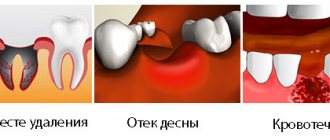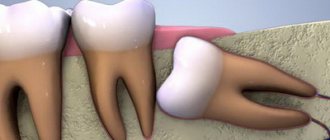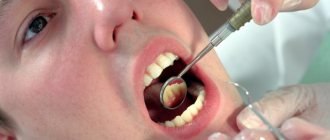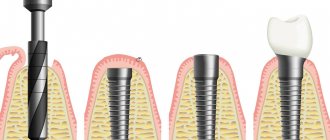What is caries?
In the general statistics of diseases of the teeth and oral cavity, the most widespread and widespread is caries.
Damage and destruction of teeth begins to develop in childhood, and for adults this disease becomes a real scourge. Caries
— from a medical point of view, it is a process of destruction of hard dental tissues against the background of changes in microflora and the spread of infections. The disease develops slowly and often without significant pain, but in advanced cases it inevitably leads to pulpitis and complete tooth destruction.
Any person can independently diagnose caries: at the first stage, local changes in the color of the tooth appear, after which a carious cavity begins to form, sensitivity to cold and hot appears, and the walls of the tooth are gradually destroyed. At the same time, not everyone who discovers the signs immediately goes to the dentist, which makes the doctors’ task very difficult, because the damage can be so serious that the tooth can only be restored using orthopedic methods.
Increased abrasion - what is it?
The term “increased abrasion” implies abrasion of the visible part of the tooth as a result of functional and parafunctional activity. If in the first case we are talking about reflex swallowing and chewing, which leads to natural abrasion with age, then in the second case, abrasion is usually caused by bruxism and clenching of teeth. It is a serious pathology and requires long-term treatment.
Both options can lead to a noticeable change in the coronal part, a decrease in the height of occlusion, transformation of the patient’s usual facial features, pulpitis, a decrease in the lumen of the root canals, increased sensitivity, high overload of the teeth, damage to soft tissues from sharp parts of damaged teeth, etc.
Should I remove the decayed tooth or treat it?
With the development of modern dentistry, many people look differently at the process of dental treatment, but there are still frequent cases when a person does not go for dental treatment solely out of fear, remembering the negative personal experience of dental treatment 20-30 years ago. And there are situations in life, everyone has their own and they are all understandable, when it is not possible to do dental treatment in a timely manner. And the inflammatory process from caries develops into deeper damage to the tooth tissue. Often the situation reaches the point where a badly damaged tooth remains in the mouth. And at this moment a person is often inclined to think that the destructive process has already gone so far that he sees no other solution to the problem other than contacting a professional dentistry center and removing the affected tooth.
We advise you not to draw independent conclusions on this matter.
What should be done in this situation?
- Make an appointment with your dentist. Moreover, you need to make an appointment not with a surgeon, but with a dental therapist and an orthopedic dentist, only the two of them decide on the possibility or impossibility of saving the tooth.
- The specialist will definitely do a computed tomography scan in the area of this tooth or suggest, if necessary, an orthopantomogram.
- Based on the examination and modern X-ray diagnostic methods, the doctor will tell you whether it is possible to cure and restore this tooth, and explain all possible restoration options.
There are often ambiguous situations when none of the doctors can guarantee with one hundred percent certainty that the tooth can be saved.
A lot depends on the body’s ability to cope with inflammatory processes. When you are offered a probable chance that the tooth will be saved or that your body will not cope and the tooth will still have to be removed, despite the money invested and the time spent, the choice will always be yours. How ready are you? There are cases when doctors give rather pessimistic forecasts for saving a tooth, but the patient is ready to try treatment, the body reacts very favorably, the cyst goes away and the tooth serves well for many years. And it happens the other way around: the forecasts are very promising, but during the treatment process some kind of failure may occur in the body and for a long time no positive dynamics are observed, or even vice versa, the affected area progresses.
In what cases do teeth definitely need to be removed:
- The crown part of the tooth has chipped deep under the gum; such a tooth can no longer be restored.
- The x-ray shows that there is resorption of bone tissue between the roots of the tooth; treatment of such a tooth is pointless, because the inflammatory process has already begun to destroy the bone and in order to stop this process of inflammation, there is only one way out - tooth extraction.
- There are large cystic formations at the apex of the root(s).
- If the jaw is severely injured, it may be necessary to remove the tooth(s).
- If a tooth is fractured (if it occurs longitudinally, its restoration becomes impossible)
- When there is severe tooth mobility.
- Eighth teeth (“wisdom teeth”), also known as third molars. They usually grow in the wrong position, put pressure on the dentition, cause crowding and put strong pressure on the adjacent seventh teeth.
- Almost always, a tooth is removed that was previously subjected to canal treatment and during the previous treatment a perforation of the root canal occurred.
- A chronic inflammatory process has already formed in the bone tissue, which cannot be treated.
- Sometimes, during orthodontic treatment, when the jaw has already formed, there is a lot of crowding of the teeth, and there is not enough room for the teeth to move to form a correct bite. The teeth that need to be removed in this case are determined by the orthodontist after diagnosis and calculations.
When you need qualified advice and help from a dentist, come to us for a consultation. You will receive answers to absolutely all questions regarding the health of your teeth. Regardless of how long you have not sought treatment from a dentist and what condition your teeth are in, you will not see reproachful glances, but will receive high-quality treatment from our doctors. As a rule, we always select a time for consultation when all the necessary specialists can spare time for a conversation with you.
Even severely damaged teeth often have a chance of recovery; consult a doctor. And it’s better to come late than completely late or never.
How is the treatment carried out?
Patients do not always begin dental treatment at the first signs of wear. Many people come to a specialist’s chair if the tooth begins to look scary and brings discomfort when eating cold or hot food.
Before starting treatment, it is important to find out the main causes of tooth abrasion, and also to evaluate what pathologies this disease can lead to, for example, malocclusion, joint pathology, and decreased occlusion. Treatment of increased tooth wear involves complex prosthetics. If necessary, the bite is also changed, and the mandatory wearing of a protective mouthguard is also prescribed.
If the patient has experienced significant tooth decay, and the lumen of the canals has noticeably decreased, recovery will be associated with a number of difficulties, since it is almost impossible to change the height of the occlusion. Also, in some cases, endodontic dental treatment will be required.
If tooth decay is insignificant, remineralization therapy should be carried out, occlusion correction through selective grinding and the use of deep fluoridation preparations.
If a patient develops concomitant pathologies, he is recommended to undergo a dental prosthetic procedure. In this case, the dentist resorts to global dental reconstruction and changes in occlusion, which is carried out only after an individual assessment of the patient’s condition according to a number of criteria.
Asymptomatic wisdom tooth - remove the 8th tooth, save the 7th tooth
A young man came to the Dial-Dent dental clinic to treat a tooth with caries. Dental treatment for caries was performed on the day of treatment. Traditionally, the patient was recommended (to assess the condition of the entire dental system) to undergo Alaverdov V.P. using modern digital diagnostic equipment.
After analyzing the image, specialists drew the patient’s attention to several serious problems (see photo below):
- The wisdom tooth on the lower left has partially erupted, as can be seen in the picture, but is tilted. A narrow gap has formed between the wisdom tooth and the 7th tooth. Food gets stuck in this gap, which first leads to bad breath, and later can lead to inflammation or gumboil.
- Using a panoramic photograph of the teeth, doctors were able to see a deep carious cavity on the seventh tooth.
What happens if you don't pay attention to a diseased wisdom tooth?
- Inflammation of the gums, swelling, gumboil.
- Pulpitis in the seventh tooth due to deep carious lesions. Only a panoramic photograph of the teeth will help determine what is causing the pain and inflammation in this case.
Asymptomatic wisdom tooth - solution to the problem
- Teeth cleaning. It is necessary to carry out a procedure to remove tartar and remove plaque. This is necessary in order to carry out wisdom tooth extraction in clean conditions. This approach significantly reduces the risk of inflammation after wisdom tooth removal.
- Wisdom tooth removal. In dental dentistry, the removal of wisdom teeth is performed by qualified maxillofacial surgeons Alaverdov V.P. and Yakimenko I.I. There is the necessary equipment and anesthesiologists to remove teeth under anesthesia.
- Healing of the gums after wisdom tooth removal usually lasts 2-3 weeks. After this, you can begin treatment and restoration of the 7th tooth. Without removing tooth 8, quality treatment of tooth 7 is impossible.
- Treatment of the 7th tooth. Note that it is extremely difficult to treat a distant tooth due to its location. For high-quality treatment, it is necessary to have high-quality equipment at the workplace and qualified assistance from a medical assistant. It should be added that it is not recommended to restore a tooth with a light-curing filling. The best restoration method in this case is a ceramic inlay.
The 8th tooth socket is covered with a special material
Advantages for patients of the treatment and diagnostic tactics offered by the Dial-Dent clinic:
- Comprehensive diagnostics - identifying hidden problems at an early stage.
- Saving the 7th tooth, the health of which is very important for the bite.
- Identifying a problem in the 7th tooth before the onset of predicted pulpitis allows you to save money on treatment, since pulpitis is more difficult to treat and therefore more expensive.
Clinical case No. 2
Causes of caries
For some people, the process of tooth decay occurs intensively, and by a certain age the number of filled teeth already outweighs the number of healthy ones.
This is not always a consequence of insufficient oral hygiene, because the occurrence of caries largely depends on quite objective factors: the quality of enamel, the composition of saliva, habits in chewing food. In other people, caries develops very slowly, which is facilitated by the increased individual resistance of dental tissues to infections, the general condition of the body, careful oral hygiene and the absence of hereditary predisposition. Women suffer from caries more often than men, since teeth are rapidly destroyed during pregnancy and breastfeeding.
Development of caries
depends on a number of other factors: age, diet, the presence of bad habits, the composition of consumed water, as well as climatic conditions and the general environmental situation, which affect the immune system and the body as a whole.
Do dental diseases of the mother affect the child?
Inflamed gums and sore teeth are a source of infection for the whole body. Microbes from a carious cavity easily penetrate through the root canal of a tooth into the blood of the mother and child, causing illness, as well as disturbances in the functioning of the heart and kidneys. An untreated infection can cause late toxicosis, fever, and general intoxication.
There is an opinion that gum infections can cause premature births and the birth of underweight children. Such babies have poor appetite, low immunity, and cry a lot for no reason.
Treatment methods
Orthodontic treatment method
The absence of incisors is dealt with by an orthodontist. There are several options for installing structures - braces, springs, rods:
- shifting the canine to the center, in place of the missing incisor. After its location there, the canine is shaped and adjusted to fit the lateral incisor. However, over time, a straight bite can form, which is a violation, leading to rapid abrasion of the enamel and disruption of the jaw joint;
- shift of the canine in the distal direction. By retracting the canine tooth toward the premolars, space is created for further implantation or prosthesis placement to fill the empty space.
Prosthetics.
After removing the incisors or creating enough space for prosthetics using orthodontic structures, the doctor chooses a method for restoring an artificial tooth.
Adhesive prosthesis
often used for anterior teeth. It is fixed to the adjacent teeth, in which special notches are made for its installation. The prosthesis is aesthetic, can withstand loads, but for its use it is necessary to exclude the presence of such factors as:
- bruxism
- mobility of supporting teeth
- severe decay of these teeth
- allergy to dental material
Filling material and veneers (Lumineers)
suitable in the absence of lateral incisors, when three gaps appear between the canine and the unit. The doctor can use a filling composite, placing it on adjacent teeth, building up and filling the space. Or use microprostheses - veneers, thin overlays that are glued onto the previously ground down surface of the tooth. Veneers and lumineers return aesthetics to the front row.
Veneers can also correct the shape of fangs after the orthodontist’s work, shifting them towards the incisors, turning them into snow-white “twos”.
Implantation
- one of the types of solution to the problem of the absence of lateral or anterior incisors. Once the site for the implantation of an artificial tooth root - an implant - has been prepared, a bed is made in the bone and gum, and installation takes place. After complete healing, the abutment and artificial crown are fixed.
The most reliable way to restore a missing incisor, but it has a number of contraindications, one of which is children under 18 years of age, while the bone is growing.
Is it possible to use anesthesia and x-rays?
If the carious infection has only slightly affected the tooth, an experienced doctor will assess individual sensitivity and, if possible, perform dental treatment during pregnancy without anesthesia.
If pain relief is necessary, choosing a safe medicine will not be difficult. Preparations that do not contain adrenaline and practically do not penetrate through the placenta to the child’s body have proven themselves to be effective.
Treatment using general anesthesia is possible in exceptional cases.
X-ray examinations are not recommended for use in early pregnancy. In the second trimester, it is possible to take dental photographs by covering the woman’s chest and abdomen with a special metal apron. The safest examination is using a dental computed tomograph. Its radiation exposure is insignificant, and the accuracy of the studies allows one to avoid diagnostic errors.
Table with clinics where to go to solve the problem of missing incisors
| braces | zirconium implant | veneers | |
| Ilatan | turnkey approx. 98,000 | 39 000 | 16 000 |
| StomDom | 85 000 | 26 000 | 22 000 |
| Implant Expert | 40 000 | 30 000 | 15 000 |
| All yours | 80 000 | 26 000 | 21 000 |
| Mendeleev | "Full construction" 177 000 | 25 000 | 13 000 |
Absence of incisors and effective techniques for correcting the situation
The absence of incisors and any other teeth in dentistry is called adentia. Congenital and acquired adentia are noted. Partial is common, but complete congenital is extremely rare. Losing all teeth is more often the fate of older people, when the functioning of the immune system and the body as a whole slows down, and a gradual loss of a large number of elements occurs.
The upper incisors are more often absent than the lower ones; the reason for this is still unknown.
If there are no incisors, this does not mean that you can leave it like that; it is better to contact a professional dentist in the clinic and correct the defect. Regardless of whether it is congenital or due to injury, unsuccessful treatment, or even an advanced disease.
There are effective techniques that can offer a solution to the problem of missing incisors:
- Orthopedic. An orthopedic dentist will offer prosthetics - crowns, bridges, microprostheses, implants;
- Orthodontic. The orthodontist determines the type of structures and braces that will help move the existing teeth to the place of the missing ones.
Each of the proposed treatment methods will help make the absence of jaw incisors invisible or replace them with artificial analogues. In no way inferior to natural teeth.
What symptoms occur?
The main symptom is the presence of pain. At first they are aching in nature, so many patients do not attach any importance to this. Over time, discomfort cannot be relieved even with the help of powerful painkillers. If you do not immediately visit a doctor and take action, on the third day swelling of the mucous membrane occurs, possibly even an increase in body temperature.
Next comes the most unpleasant moment - the putrefactive process. A bad odor appears from the mouth, and a white coating is noticeable around the hole. It doesn’t come to this very often, since severe pain in most cases provokes a person to go to the dentist again.
Symptoms of caries
A disease such as caries has always been considered the most common. Every person can detect it in themselves based on a number of signs. These include darkening of the enamel, the formation of a white spot on it (demineralization), a rather noticeable reaction to temperature stimuli, and, ultimately, the appearance of a small hole on the tooth.
Causes for tooth decay
enough. The most important of them are the quality of enamel, hereditary predisposition, a certain diet (soft, sweet food), the quality of drinking water and irregular cleaning of the oral cavity.
If you detect the signs of caries in time, you can get by with a regular filling without the risk of going to an orthopedic doctor or surgeon.
Possible reasons
An experienced doctor will always make sure that the unit is completely removed. If the case was complex, additional radiography may be performed. There are several reasons why this complication can occur:
- Removal of a complex tooth when an adjacent unit is accidentally affected during the operation. This usually leads to the destruction of the adjacent tooth, and a small fragment ends up in the injured socket.
- Unsatisfactory condition of the tooth root. When removed, pieces of the root may break off, especially if it is susceptible to rotting.
- Often, a splinter remains in the tooth due to incorrect movements while removing the tooth from the socket.
Duration of treatment
There is no quick way to correct the situation with the absence of an incisor. Unless it is immediate implantation after removal. In other cases, the work of an orthodontist is necessary to form a place for the future chosen prosthesis (a year or two). If it is a veneer, then its installation will take up to a week (until the individual microprosthesis is ready), the same with an adhesive bridge in time. Implantation depends on osseointegration of the artificial root. It may take several months. But this method of restoration lasts for many years; you only need to take care of the crown.











